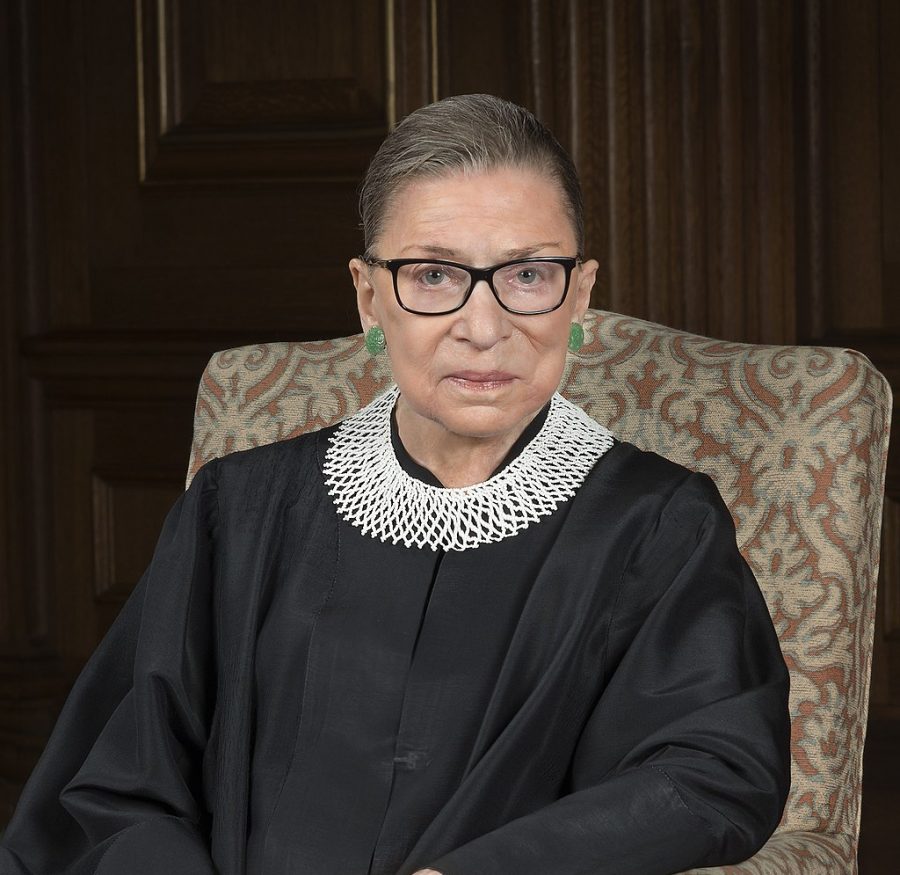The Supreme Court of the United States
Supreme Court Justice Ruth Bader Ginsburg left her mark after passing on Friday, Sept. 18.
RBG: her life and legacy
September 25, 2020
Did you know?
Early Years:
- She entered Cornell University on a full scholarship.
- (1954) Graduated from Cornell at the top of her class.
- After graduating Cornell, she continued her studies at Harvard Law School where she was one of nine women out of a class of 500.
- The first woman to become a member of the editorial staff of the Harvard Law Review.
- (1959) Ruth finished her legal education at Columbia Law School where she graduated at the top of her class.
Occupation:
- (1959-61) Despite having excellent credentials, she struggled to find work because she was a woman and a mother. However, after one of her Columbia law professors recommended her and convinced Judge Edmund Palmieri to offer clerkship to Ginsburg, she was able to find a job.
- (1963) When hired by the Rutgers School of Law as an assistant professor, she was asked by the dean of the school to accept a low salary because of her husband’s well-paying job.
- (1970) Became professionally involved in the issue of gender equality when asked to introduce a student panel discussion on the topic of “women’s liberation”.
- (1971) Published two law review articles about “women’s liberation” and taught a seminar on gender discrimination.
- (1972) Became founding counsel of the ACLU’s (American Civil Liberties Union) Women’s Rights Project and co-authored a law school casebook discussing gender discrimination.
- (1972) Became the first female to have an occupation as a faculty member at Columbia Law School.
- (1980) Democratic U.S. President Jimmy Carter appointed Ginsburg to the U.S. Court of Appeal for the District of Columbia Circuit.
Appointed Supreme Court Justice
- (1993) Former Democratic U.S. President Bill Clinton nominated Ginsburg to the Supreme Court. She was supported unanimously by the Senate Judiciary Committee and confirmed by the full Senate on August 3rd by a vote of 96-3.
- Although Ginsburg tended to vote with other liberal justices in Court, she got along well with most of her conservative peers including Justice Sandra Day O’Connor and Justice Antonin Scalia.
What else has she done for women?
- Before Ginsburg, state funded schools didn’t have to admit women.
- (1996) United States vs. Virginia case: Ginsburg wrote the majority opinion that it’s unconstitutional for state-funded schools, schools funded by taxpayer dollars, to have the authority to not have to admit women.
- Before Ginsburg, women couldn’t sign a mortgage or have a bank account without a male co-signer.
- (1974) Ginsburg helped to introduce and carry out the Equal Opportunity Act, which passed in 1974. This act allowed women to apply for credit cards and mortgages without a male co-signer.
- Ginsburg helped women come closer toward equal pay.
- (2007) Ginsburg descended from the Supreme Court’s decision on the pay discimination case Ledbetter vs. Goodyear Tire & Rubber Co.
- Ginsburg helped the Supreme Court preserve Roe vs. Wade.
- This was the case in which the Supreme Court found it a constitutional right for women to have abortions.
- Ginsburg argued that excluding or firing a woman from the workspace because of her reproductive choices is sex discrimination.
- Ginsburg argued that women should serve on juries.
- (1979) Duren vs. Missouri case: jury duty was optional for women in many states because it was viewed as a burden for women whose role was seen as “the center of home and family life.” Ginsburg argued that women should serve on juries on the basis that they are valued the same as men.
- Ginsburg was a key vote in granting same-sex marriages.
- (2015) Obergefell vs. Hodges Case: allowed queer women and all of the LGBTQ+ community the right to same-sex marriages in all 50 states. This ended in a 5-4 ruling.
Hearing the news
I’m standing at the kitchen sink about to put my plate in the dishwasher when I look out the window and see my mom crying. I run outside and I’m trying to get my dad to tell me what is happening. Finally, he looks up and says “RBG died.”
Now, this may seem dramatic to some, but Justice Ruth Bader Ginsburg is an inspiration to my mom and I, and a trailblazer when it comes to women’s rights. In my family, RBG is a big deal. That’s saying it lightly. To be honest, we thought she was invincible after surviving cancer five times and working at the highest court in the nation throughout it all.
I experienced this moment of panic when I heard the news and it kept resurfacing; a moment where I was just terrified of what is going to happen to women’s rights without the protection of Ruth Bader Ginsburg. This justice was the biggest protector of Roe v Wade left on the conservativley leaning court, and as a woman, the loss of that reassurance of my rights is terrifying. Women have already faced several attacks on healthcare during the Trump administration and this short period of time before January and possibly another four years, could lead to the destruction of a law that protects so many. Keep in mind, I am including access to cancer screenings, birth control, rape counseling and reproductive health. These things benefit everyone and it’s horrible to be stuck waiting for the potential final blow now that RBG isn’t here anymore to stand up for women’s rights.
Ruth Bader Ginsburg served as a justice on the Supreme Court for 27 years and vowed she would continue to do so until she absolutely could not, which we have seen this week. While Ginsburg is viewed as a champion of women’s rights, she went about improving women’s rights in the Constitution in a way that had never been done before. She made it about men’s rights. This was Ruth Bader Ginsburg’s greatest trick and is why so many loved her; she could appeal to the court by presenting a women’s issue as a men’s issue and therefore fight for equality.
In this case, Califano v. Goldfarb, Leon Goldfarb’s wife died in childbirth. He wanted to be able to stay home and raise his daughter, but when he applied for survivor’s benefits under the Social Security Act, he found that only women who have been widowed would be eligible for benefits if their spouse was responsible for half of the family’s income. RBG argued this case in front of the Supreme Court during her litigator days and was able to change the law to support both men and women.
She taught us the value of having friends you don’t agree with. Perhaps her most famous friendship was with justice Scalia, who was an extremely conservative member of the Supreme Court, but the pair enjoyed attending operas together and built a lifelong friendship despite their political differences.
Another crucial lesson RBG taught women was that you could be a mom, a grandmother and graduate from Harvard Law and work as a fierce litigator and serve as a level headed justice. She was the real life Elle Woods, without the pink. We all remember the videos of her boxing during her workouts just a few months ago. Ginsburg was uniquely suited to her position because she catered to young people. She earned the nickname Notorious RBG after the rapper Notorious B.I.G. and she fully embraced meme culture.
As a justice, Ruth Bader Ginsburg wasn’t just a little old lady sitting in a big chair, she was a powerful woman who captured the attention and awe of generations for her work. She will be remembered as a pioneer and as an official beloved by the people.

Katie McClellan is a senior and this is her second year on staff. She's also a member of the yearbook staff and NHS. Katie loves to read, write, advocate,...
